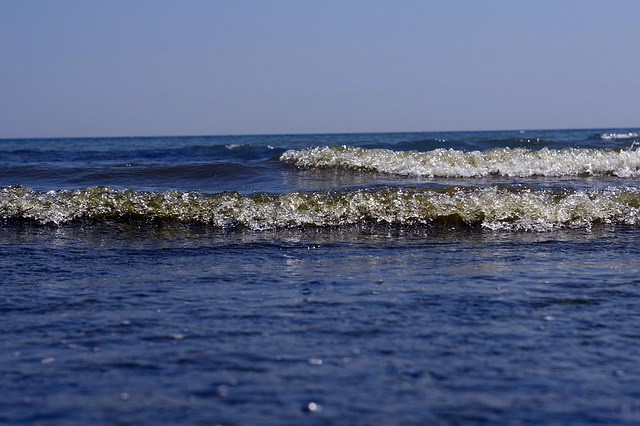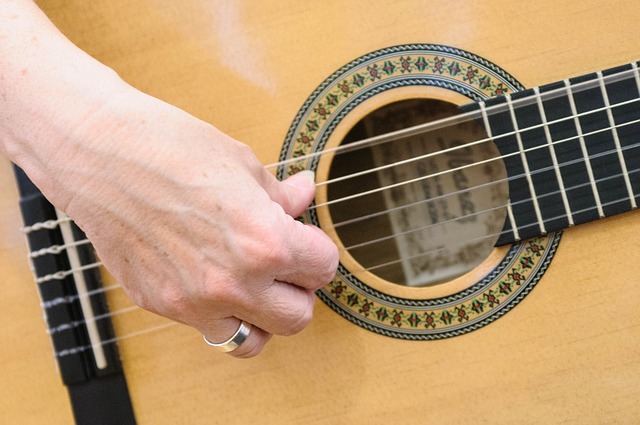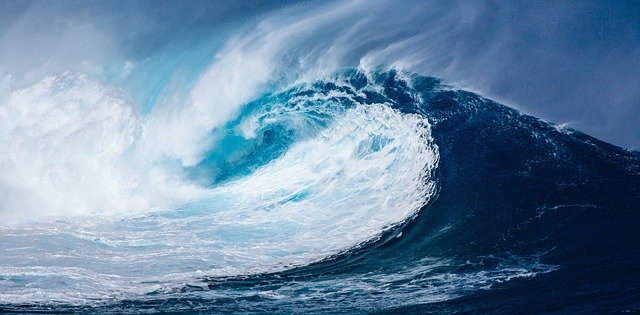In this article, we are going to discuss various transverse wave examples with detailed information and facts.
The transverse wave is a short-range propagation that comes into existence due to the vibrational motion of the particles. The following is the list of the transverse wave examples:-
Ripples on water
A ripple produced on the water is an example of a transverse wave traveling on the layer of water.
The disturbance generated in the water produces transverse waves on the water in the form of ripples that vanishes to a certain extent. The water molecules move up and down from the place perpendicularly to the wave direction.
Shear waves due to earthquake
The geo-tectonic activities on the Earth give out shear waves, that travel through the solid surface of the Earth that is on the crust as it can’t penetrate through the asthenosphere because it is in liquid form.
The converging or diverging of the plates is responsible for the earthquakes. These propagating shear waves move the particles present in the crust or rocks up and down the motion perpendicular to the direction of propagation of the shear waves.

Image Credit: Pixabay
Coherent Sources of Light
When a source emits light of constant wavelength and frequency, the source is said to be a coherent source of light. The light waves travel in the direction perpendicular to the direction of the particle, hence is a transverse wave example.
If the two transverse waves of light superimpose on each other then we get either constructive interference or destructive interference of light. The constructive interference is when the crest of waves falls on each other giving the bright fringes of light and when the crest of one wave falls on the trough of the other wave, that cancels out the amplitude of the superimposing waves giving dark fringes as the intensity of light at this phase is zero.
Read more on Is Light a Transverse Wave: Why, How and Detailed Facts.
Pendulum
The pendulum in a simple harmonic motion oscillates continuously while the oscillations are maintained by the string it is attached to which is fixed at one point.

The oscillation of the pendulum is periodically at a mean position of a bob, and perpendicular to the direction of movement of a bob. Hence, this is also a type of transverse wave.
If you plot a graph of position v/s time of an oscillating pendulum considering the initial position of the bob at rest at the origin of a graph when time T=0, then you will find a sinusoidal wave on the x-axis with continuous decreases in the amplitude of the waves. This is because the energy of the pendulum dissipates due to the damped simple harmonic motion of the pendulum.
Sunlight
The vibration of a quantum of light is in a direction perpendicular to the wave. It is also called the electromagnetic wave because of its characteristics.

The light wave is received on the crystal of the eye and the visible spectrum is visible to the human eyes.
Read more on What is Light Energy? | Interactions of light | It’s important uses.
Concentric waves on the surface of the water on tapping the stone
On throwing the stone in the water bodies, the circular wavy pattern is generated that travels for a certain distance apart and disappears.

Image Credit: Pixabay
Due to the waves developed on the layer of water, the water moves up and down, the position of the particle remains the same but because of the transverse wave the water appears to be in motion, well, it is not so.
Electromagnetic Waves
The ray of light that shows both electric and magnetic characteristics is called electromagnetic light. Sunlight is also electromagnetic in nature. The direction of the electric field applied and the magnetic field produced both lie perpendicular to each other.
X-rays used to scan the inner parts of the body is also an example of electromagnetic wave. Since the field lines produced are perpendicular to the motion of particles and the electric field, this is also an example of transverse waves.
Read more on 16+ Amplitude Of A Wave Example: Detailed Explanations.
Oceanic Waves
The waves formed in the oceanic water are transverse waves. They come from the mid-ocean, approach the shore, and vanish.

The water molecules on the surface of the water oscillate with the wave while the transverse wave travels perpendicular to the direction of the molecules.
The oceanic wave is associated with huge energy. The potential energy of the wave is transported to shore by converting it into kinetic energy and the wave returns back to the shore converting kinetic energy back to the potential energy.
Waves from on the string of wire
If you tie one end of the rope and wave a rope up and down position, we get a transverse wave. The wave started at one end will travel across the rope and will vanish at another end of the rope. Only the wave will propagate away from you while the particle on the rope will remain at the same locality.
Plucking a string on a guitar
We plug strings of the guitar to play the notes all the time. On plucking the string, the transverse waves are set onto the string due to which the string starts vibrating.

The sound produced by the guitar is a longitudinal wave that travels parallelly from the sound hole of the box guitar. The speed of the wave relies upon the tension applied to the string while plucking the note and the density of the string. It is given by the relation
v=√(T/mu)
Where v is a speed of a wave
T is a tension applied to the string
mu is a linear density of a string
Read more on Properties Of Refraction: Wave, Physical Properties, Exhaustive Facts.
Slinky
Slinky can be an example of both transverse and longitudinal waves. If you hold one end of the slinky and give it a wave by moving a hand up and down position, then the transverse wave will travel from one end to another and vanish.

Image Credit: Pixabay
If you suspend a slinky freely in the air, then you will notice that the wave is set into motion in a slinky that will move up and down the slinky moving coils. These are also transverse waves.
Tsunami
The ocean waves formed due to tsunami shows both types of waves.

In the place where the volcano erupts on the oceanic floor, the transverse waves are seen in the ocean that gradually turns into a longitudinal as the wave approaches the shore.
Read more on 10+ Causes Of Interference Of Light: Detailed Facts.
What are transverse waves?
Transverse waves are called shear waves, or s-waves that travel through the crust of the Earth due to plate tectonic activities.
The vibrations produced in the particle give a form of waves due to oscillations of the particles up and down. These waves are called transverse waves. These are short-ranged waves and do not penetrate through the fluid mediums.
The transverse waves are stimulated by some disturbances and vibrations produced. This vibration sets the molecules in the object to oscillate up and down motion that creates the wavy pattern.
How to Calculate the Speed of the Transverse Wave?
A complete one oscillation of a particle in a time period ‘T’ is called the wavelength of that particle.
The ratio of wavelength and the time required for one wavelength gives the speed of the wave. Hence, the speed of the wave is measured as
v=λ/T
The frequency of the transverse wave is the total number of waves passing through in a unit interval of time.
f=1/T
Therefore the velocity of the transverse wave is the product of the frequency of the wave and its wavelength.
v=λf
Read more on 8+ Wave Properties Of Diffraction: Detailed Facts.
Characteristics of a Transverse Wave
- The propagation of a wave is in the direction perpendicular to the motion of the vibrating particle.
- The time taken to complete one oscillation by the particle, that is a time required to travel on wavelength is defined as a time period of a transverse wave.
- The speed of a transverse wave is equal to the product of its wavelength and the frequency of occurrence of a transverse wave in a unit of time.
- The transverse wave is also called a shear wave as the vibrational motion produced by the particle may result in the deformation of the object.
- The transverse wave does not travel through the liquid state, they travel only in the direction perpendicular to the motion of the particles in the fluid.
- The transverse wave propagates at lower velocity and only in a solid and gaseous states.
- The velocity of the transverse wave in the liquid is zero.
- If the velocity of the transverse wave is more, then the energy associated with the transverse wave is more.
Frequently Asked Questions
What is the energy associated with the transverse wave?
If the number of oscillations due to vibrations of a particle is more in a given time period, then the energy of the particles is more.
The energy of a wave is directly dependent on the frequency of occurrence of waves in a unit of time. The total number of oscillations completed by the particle in a unit of time is the frequency of the particle.
Why transverse wave does not travel through fluids?
The transverse wave is generated due to the vibrations of the particle and travels perpendicular to it.
Transverse wave does not travel through fluids as no motion is driven in the direction perpendicular to the propagation of a wave.
Does the transverse wave get reflected?
A transverse wave is reflected when it is not able to transmit through the medium.
The reflected transverse wave will show the phase of π/2 from the incident wave, that is the crest of an incident wave will become a trough of a reflected wave.
On what factor does the speed of a transverse wave depend upon in the medium?
If the refractive index of the medium is more, then the speed of a wave will be very less through the medium.
The speed of the transverse wave depends upon the density of the medium of its propagation. It also relies upon the tension generated that results in the vibrational motion of a particle.
Read more about Tsunami.
Also Read:
- Aufbau principle example
- Longitudinal wave example
- Dynamic equilibrium example
- Destructive interference of wave example
- Homogeneous mixture example
- Negative velocity example
- Motion parallax example
- Limiting reactant example
- Example of eukaryotic cell
- Hypertonic solution example
Hi, I’m Akshita Mapari. I have done M.Sc. in Physics. I have worked on projects like Numerical modeling of winds and waves during cyclone, Physics of toys and mechanized thrill machines in amusement park based on Classical Mechanics. I have pursued a course on Arduino and have accomplished some mini projects on Arduino UNO. I always like to explore new zones in the field of science. I personally believe that learning is more enthusiastic when learnt with creativity. Apart from this, I like to read, travel, strumming on guitar, identifying rocks and strata, photography and playing chess.